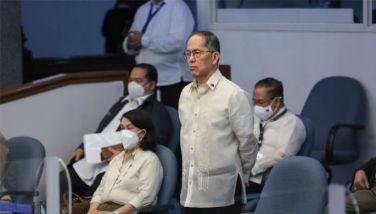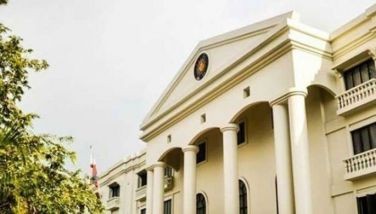Abu Sayyaf behind Zamboanga bombings PNP
ZAMBOANGA CITY – Government security forces tagged yesterday the Abu Sayyaf Group (ASG) for the twin bombings at the city cathedral here at dawn Sunday.
Police released the sketch of one of the suspects during a security briefing with City Mayor Celso Lobregat, who vowed the immediate capture of the bombers.
Lobregat announced that the city government is ready to give a reward to any informant who would lead authorities to the arrest of the suspects.
“We assure you that the city is exhausting all its resources to solve the bombings at the soonest possible time,” he told newsmen.
Acting city police director Superintendent Jonathan Perez said the ASG has remained the primary suspect in the bombing of the Metropolitan Immaculate Cathedral and the building premises that housed the MayBank and Department of Foreign Affairs (DFA).
“There have been threats in our area of responsibility and they (Abu Sayyaf men) are the ones who could have done it,” Perez said.
However, he said joint police and military operatives are expanding their investigation to determine who planned the bombings aimed at blowing up the main hall of the church where Mass was regularly held.
Perez said four witnesses described one of the suspects as being in his 30s, with brown complexion and slim build, about five feet five inches tall.
Combined police and military intelligence units were tracking down the suspects after civilian informants gave vital tips, said Superintendent Lurimer Detran, Police Regional Action Force commander.
Anti-terror Task Force Zamboanga commander Col. Darwin Guerra said Marines in Basilan and Sulu have been alerted to be on the lookout for the suspects.
US assists in probe
As this developed, US military bomb experts were helping local military and police to determine the signature of the bomb used in the incident.
“The US military support was more of technical assistance and analysis of the fragments of the bomb,” Superintendent Jose Bayani Gucela, police regional head of the Explosive Ordnance and Disposal (EOD) unit, said.
A contingent of more than 300 US military is based in this city helping the military in the global war on terrorism.
Gucela said the bombs used in the twin attacks Sunday were similar to the bombs used in Jolo, Central Mindanao, and Manila.
“The signature was the same based on the result of the post blast investigation. It could be one group responsible for the attack,” he said.
The bomb used in the church was fashioned from one 60-millimeter and one 8 mm mortars with a digital timer, while the bomb that went off in the building premises along Veterans road comprised three 60 mm mortars with a cell phone as a triggering device.
Another police official disclosed that two bombs were to be planted at the second level of the main hall of the Metropolitan Immaculate Conception Cathderal.
However, the timely presence of the church caretaker forced the suspects to leave one of the bombs at the side of the church premises and dump the other bomb on Veterans road to avoid detection.
The police said the digitally timed bomb was used as the primary bomb and the cellphone-triggered bomb would be detonated once the police gathered at the site for maximum casualties.
Meanwhile, the situation has returned to normal as people flooded various commercial establishments in the area. Restaurants were full and church activity went on uninterrupted, Lobregat said.
He lauded the residents’ resiliency in time of crisis and called on their vigilance to report suspicious people or activities in their communities.
Hunt for bomber
The military is continuing its hunt for Indonesian bomb expert Dulmatin, after Filipino and US forensics experts failed to find conclusive evidence that would confirm the death of the foreign terrorist, a ranking official said.
Maj. Gen. Juancho Sabban, commander of the Sulu-based Joint Task Force Comet, said in a phone interview that soldiers are continuously scouring the hinterlands of the province in an effort to locate not only Dulmatin, but his fellow Jemaah Islamiyah member Umar Patek, whose wounding in an encounter several months back has yet to be validated.
“Our operations are ongoing because there are no official findings yet on the DNA test on the cadaver that was believed to be that of Dulmatin,” Sabban said.
He said intelligence reports showed that the foreign terrorists and their Abu Sayyaf cohorts are still isolated in the jungles of Sulu and have not slipped past military dragnets.
Sabban said they have not received information that Dulmatin, who carries a $10-million bounty on his head, has escaped to Malaysia to meet with another terrorist leader and plan attacks in the Philippines.
Dulmatin and Patek have been the subject of manhunt operations in Sulu since Aug. 1.
The military is also tracking down remaining Abu Sayyaf leaders Radullan Sahiron, Albader Parad, Abu Pula, and Isnilon Hapilon.
Dulmatin and Patek are both wanted by the US government for the 2002 attack in the resort island of Bali, Indonesia in 2002 that left 202 people dead. The bombing is considered the worst terrorist attack in Southeast Asia.
President Arroyo has ordered the Armed Forces of the Philippines to crush the local bandit group and their foreign cohorts.
The AFP has been getting technical assistance from the US military in its hunt for the terrorists. – Roel Pareño, James Mananghaya
- Latest
- Trending
































